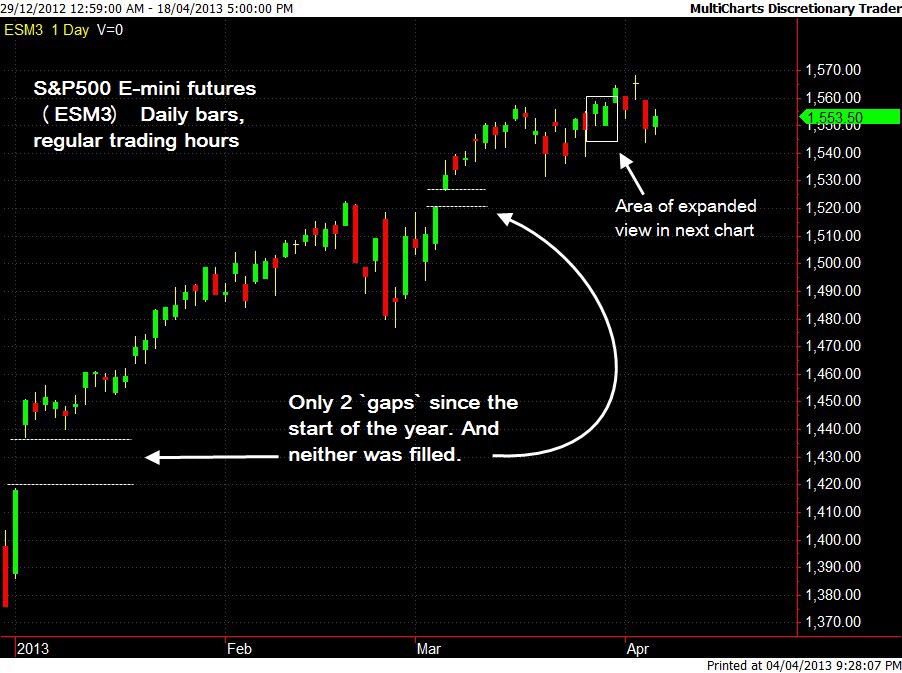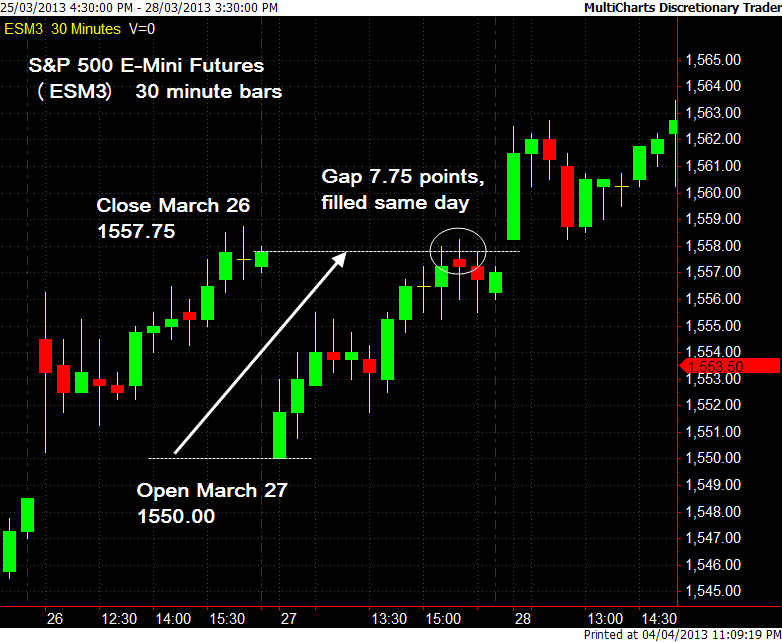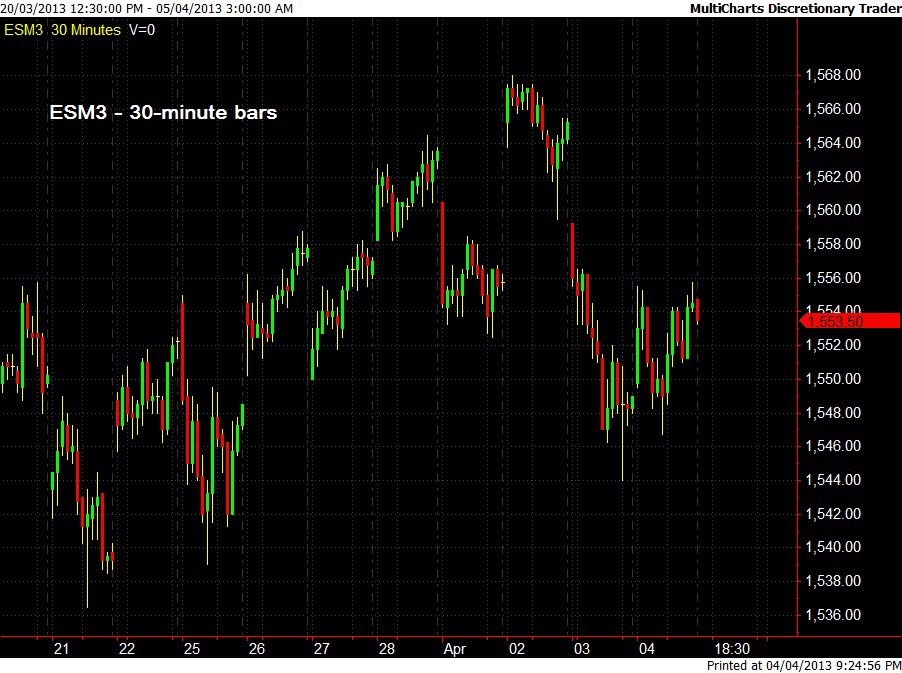Ever since Charles Dow developed the Dow Industrial average in 1880, traders have been using the tools of technical analysis to capture – and profit from – predictable price changes in stocks.
There’s nothing strange in this. Everyone who trades, even casually, knows about support and resistance, breakouts and reversals, and the value of chart patterns in anticipating the next move.
REFINE YOUR METHODS FOR FUTURES
The same tools are even more valuable to futures traders. But the methods you use to analyze stock movements need to be refined a little before you use them for trading futures. If you just try to apply stock trading methods directly to futures, you’ll find it tough to make money.
But once you learn the tricks, they work well.Let’s look at an example.
TRADING GAPS
For technical traders, the textbook for charting price action is Technical Analysis of Stock Trends by Robert Edwards and John Magee. First published in 1948 and currently in its 10th edition, it is generally considered the best book on chart patterns ever written. And it is.
But because it concentrates on stocks, it doesn’t capture the opportunities available to futures traders. For example, Magee debunks the common belief that the market will return to fill in price gaps – areas where no trades occur. He argues that price is no more likely to return to fill a gap than it is to return to any other level.
FUTURES ARE DIFFERENT
Nobody is going to argue with John Magee (or the current editor, W.H.C. Bassetti) about stock patterns. But when it comes to futures, especially the index futures that are our main trading vehicle … well, our experience is different.
We define gaps a little differently than TAST. And we find that much more than half of the price gaps – perhaps 75% or more – are filled, often within an hour.
Here are two charts that illustrate the point.

Figure 1 Caption: S&P 500 E-mini futures showing ‘gaps’ as usually defined by stock traders.
By this measure, there were only two gaps in the e-mini index futures since the start of the year … and neither one has been filled. That supports the Edwards and Magee view.
But when you look more closely, at the intra-day level short-term traders like us use, there is a different picture. We usually regard a ‘gap’ as the difference between yesterday’s close and today’s open. And those gaps are filled most of the time, often the same day, and sometimes within a few minutes.
A DIFFERENT VIEW
Figure 2 shows this microscopic view and a typical short-term gap trade. The E-mini (ESM3) gapped down 7.75 points overnight and climbed back to fill the gap before the close. And if you entered on the open, you were in the money all day long.

Figure 2 Caption: E-mini futures March 26 – 27, 2013. 30-minute bars
This type of gap is very frequent in index futures. In fact we expect to see – and trade – this gap two or three times every week. Figure 3 shows just how often these gaps appear. In two weeks of data we can see about six tradable price gaps. Can you?

Figure 3 Caption: ESM3 March 20 – April 4 2013
HOW WE TRADE THE GAPS
We look for price gaps between yesterday’s close and today’s open, and also between yesterday’s high or low, and today’s open.
When we see a price gap we believe is “tradable” we enter on the assumption the gap will be “filled” – i.e. that the price will move back to the point where the gap originated.
Since index futures trade almost 24 hours a day in the Globex market, we will sometimes enter gap trades in the pre-market before the open, if the price has moved a significant distance from the previous close.
Often these are more profitable trades; there is a tendency for the price to move back toward the previous close as we get closer to the open.
SOME NUANCES
But not all gaps are created equal. If the gap is too small there may not be enough profit to justify the trade. If it is too large – in the E-minis, if it is more than 12 points – we will not take a gap trade.
Those gaps may fill, but not usually on the same day, and we don’t like to hold positions overnight … precisely because there are often significant price moves in the overnight market.
We want to see the gap fill early, without a large adverse movement, and we will sometimes dump a trade if it takes too long to fill, or if it moves dramatically against us. Sometimes we will take profits at half of the gap; we often take partial profits as they become available.
We watch the overall direction of the market as a guide to the likelihood of the gap being filled, especially a gap against the prevailing trend. A gap down in a rising market is often filled quickly.
And we keep an eye on the behavior of the different sectors after the open. If there is a gap down and all the market sectors are red after the open, the gap is not likely to be filled, or not in the time frame we are interested in.
You have to be nimble to trade this way. There are not many rotisserie traders – “just set it and forget it” – making money by trading the gaps.
But if you pay attention and pick your spots, gap trades are consistently profitable. And they come around often enough to make it worth your while to learn the little tricks that turn them into regular money-makers … Edwards and Magee notwithstanding.
BOTTOM LINE
The traditional tools used to analyze stock charts work well on futures contracts. But you have to use them a little differently to get the best results – especially in short-term trades.
#####
For timely market analysis, check out our daily commentary on TraderPlanet …
Related Reading …




